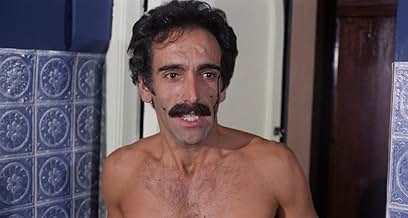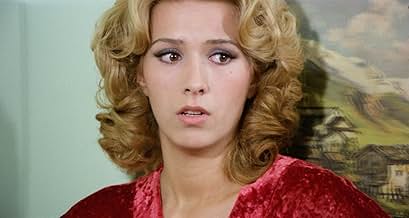Un escritor se hospeda en un parador regentado por una mujer marcada por los malos tratos a los que fue sometida por su marido. Entabla una buena relación con ella, ignorando que se trata de... Leer todoUn escritor se hospeda en un parador regentado por una mujer marcada por los malos tratos a los que fue sometida por su marido. Entabla una buena relación con ella, ignorando que se trata de una perturbada mental con instintos homicidas.Un escritor se hospeda en un parador regentado por una mujer marcada por los malos tratos a los que fue sometida por su marido. Entabla una buena relación con ella, ignorando que se trata de una perturbada mental con instintos homicidas.
- Dirección
- Guión
- Reparto principal
Heinrich Starhemberg
- Daniel
- (as Henry Gregor)
Tony García Jr.
- Young Boy
- (as Tony Garcia Pablo)
León Klimovsky
- Paisano
- (sin acreditar)
Reseñas destacadas
Iolación fatal is a grim, unsettling entry in the late-70s wave of Spanish exploitation cinema, wrapped in the aesthetics of a psychological thriller but weighed down by uneven execution. While the film touches on disturbing themes and presents a few stylistic flourishes, it struggles to rise above the genre's more gratuitous tendencies.
Atmospherically, the film succeeds in creating a sense of dread. The lighting is often stark and moody, particularly in interior scenes where shadows feel like silent observers. Cinematographer Francisco Sánchez captures a creeping tension in narrow hallways and dimly lit bedrooms, often allowing the frame to linger just long enough to unsettle. Yet, this stylistic care doesn't always carry through. Some scenes fall flat visually, with pedestrian compositions or abrupt edits that undercut their emotional weight. There's a disconnect between the visual intent and the rhythm of the narrative, which makes the film feel choppy at times.
Performance-wise, the cast handles the material with varying degrees of conviction. Ágata Lys delivers a haunting and layered performance, striking a delicate balance between vulnerability and restrained strength. Her presence anchors the film, elevating scenes that might have otherwise veered into exploitation without nuance. In contrast, some supporting actors fall into melodrama, lacking the subtlety the script seems to call for. Still, even with these inconsistencies, there's a raw sincerity in several exchanges that makes the human drama feel real, if not always well-paced.
The film's major flaw lies in its tendency toward sensationalism. At points, it leans heavily on nudity and lurid scenarios to provoke rather than explore. This often blunts the psychological depth the film flirts with, leaving some scenes feeling gratuitous instead of essential. There's an undercurrent of commentary about trauma and guilt, but it never fully matures into something cohesive. Instead, the movie circles its themes, hesitant to confront them head-on.
In the end, Violación fatal is a mixed bag. It has moments of genuine tension and some striking visual choices, but it lacks the narrative focus and restraint to elevate its subject matter. Ágata Lys's performance remains the most memorable element, a compelling center in a film that too often drifts toward exploitation without clear purpose.
Atmospherically, the film succeeds in creating a sense of dread. The lighting is often stark and moody, particularly in interior scenes where shadows feel like silent observers. Cinematographer Francisco Sánchez captures a creeping tension in narrow hallways and dimly lit bedrooms, often allowing the frame to linger just long enough to unsettle. Yet, this stylistic care doesn't always carry through. Some scenes fall flat visually, with pedestrian compositions or abrupt edits that undercut their emotional weight. There's a disconnect between the visual intent and the rhythm of the narrative, which makes the film feel choppy at times.
Performance-wise, the cast handles the material with varying degrees of conviction. Ágata Lys delivers a haunting and layered performance, striking a delicate balance between vulnerability and restrained strength. Her presence anchors the film, elevating scenes that might have otherwise veered into exploitation without nuance. In contrast, some supporting actors fall into melodrama, lacking the subtlety the script seems to call for. Still, even with these inconsistencies, there's a raw sincerity in several exchanges that makes the human drama feel real, if not always well-paced.
The film's major flaw lies in its tendency toward sensationalism. At points, it leans heavily on nudity and lurid scenarios to provoke rather than explore. This often blunts the psychological depth the film flirts with, leaving some scenes feeling gratuitous instead of essential. There's an undercurrent of commentary about trauma and guilt, but it never fully matures into something cohesive. Instead, the movie circles its themes, hesitant to confront them head-on.
In the end, Violación fatal is a mixed bag. It has moments of genuine tension and some striking visual choices, but it lacks the narrative focus and restraint to elevate its subject matter. Ágata Lys's performance remains the most memorable element, a compelling center in a film that too often drifts toward exploitation without clear purpose.
A writer stops off at a secluded bed and breakfast run by the battered wife of a mysterious man who spends all his time upstairs in his room. That is except when he's killing off the lodgers downstairs.
If you've seen more than 3 horror movies in your lifetime, the big twists in Trauma won't come as any big surprise, but it's not the worst film of its type and it keeps things entertaining. It features a lot more sexuality than expected with just about everyone in the film getting naked and having sex at some point. The gore effects are of the cheap variety with some razor slashes that don't completely convince.
If you've seen more than 3 horror movies in your lifetime, the big twists in Trauma won't come as any big surprise, but it's not the worst film of its type and it keeps things entertaining. It features a lot more sexuality than expected with just about everyone in the film getting naked and having sex at some point. The gore effects are of the cheap variety with some razor slashes that don't completely convince.
There are some interesting ideas here. It's a whodunit with some Norman Bates moments and an ending that is open to interpretation which I thought was unique for this type of movie.
The lead actress, Ágata Lys, was great! The rest of the cast ranged from forgettable to bad.
I found the directing to be quite bad. It had a made for TV feel to it.
There's quite a bit of sleaze and nudity here. With the exception of the final murder, the violence and special effects were laughably bad. I thought the execution of the last girl's death was a cut above the rest.
The score was better than average.
I enjoyed the ambiguous ending.
The lead actress, Ágata Lys, was great! The rest of the cast ranged from forgettable to bad.
I found the directing to be quite bad. It had a made for TV feel to it.
There's quite a bit of sleaze and nudity here. With the exception of the final murder, the violence and special effects were laughably bad. I thought the execution of the last girl's death was a cut above the rest.
The score was better than average.
I enjoyed the ambiguous ending.
Not long after inn landlady Veronica first appeared on-screen, it became abundantly clear to me that she was barking mad, making her more than likely responsible for the series of vicious open razor murders that ensued. If it turned out that she wasn't the killer, then director León Klimovsky would be a master of deception on a par with Alfred Hitchcock (whose classic Psycho was clearly the blueprint for this film).
As I suspected, Klimovsky is no Hitchcock.
Veronica, played by lovely Ágata Lys, is easier on the eye than Norman Bates, but no less loopy, bumping off her less respectable guests in bloody fashion with the same razor that she used to do in her husband, whose persona she subsequently adopts to kill. The only occupant of the inn who she doesn't target is Daniel (Heinrich Starhemberg), a chubby, balding writer with a weak chin and terrible fashion sense to whom she takes a shine (for some inexplicable reason, he is quite the fanny magnet). Will Daniel discover the truth about Veronica before she can turn her razor on his wife Elena (Sandra Alberti), who turns up at the inn looking for her hubby?
WIth the plot providing very little in the way of genuine mystery, Klimovsky peps up his movie with plenty of mean-spirited violence (the murders aren't all that convincing, employing one of those props that squirts bright red blood from the blade, but they are still quite nasty in tone) and a fair amount of sleaze, nudity and sex: the lovely Lys gets nekkid, as does Alberti, with extra T&A from Irene Foster as pretty backpacker Anna, and Isabel Pisano as busty hooker Eva. Less appealing is the sight of Starhemberg's naked thrusting butt as he gets it on with his wife.
Trauma is a long way from a top tier giallo, but the pace is snappy and the performances fun, while the trashiness of the whole thing ensures an entertaining enough time for fans of the genre.
6.5/10, rounded up to seven for the excess of wonderfully tasteless wood panelling at the inn.
As I suspected, Klimovsky is no Hitchcock.
Veronica, played by lovely Ágata Lys, is easier on the eye than Norman Bates, but no less loopy, bumping off her less respectable guests in bloody fashion with the same razor that she used to do in her husband, whose persona she subsequently adopts to kill. The only occupant of the inn who she doesn't target is Daniel (Heinrich Starhemberg), a chubby, balding writer with a weak chin and terrible fashion sense to whom she takes a shine (for some inexplicable reason, he is quite the fanny magnet). Will Daniel discover the truth about Veronica before she can turn her razor on his wife Elena (Sandra Alberti), who turns up at the inn looking for her hubby?
WIth the plot providing very little in the way of genuine mystery, Klimovsky peps up his movie with plenty of mean-spirited violence (the murders aren't all that convincing, employing one of those props that squirts bright red blood from the blade, but they are still quite nasty in tone) and a fair amount of sleaze, nudity and sex: the lovely Lys gets nekkid, as does Alberti, with extra T&A from Irene Foster as pretty backpacker Anna, and Isabel Pisano as busty hooker Eva. Less appealing is the sight of Starhemberg's naked thrusting butt as he gets it on with his wife.
Trauma is a long way from a top tier giallo, but the pace is snappy and the performances fun, while the trashiness of the whole thing ensures an entertaining enough time for fans of the genre.
6.5/10, rounded up to seven for the excess of wonderfully tasteless wood panelling at the inn.
Another "Trauma"? If I put aside a dollar for (horror) movie I watched with as title - or as a.k.a. Title - "Trauma", I could at least treat myself to a lunch at McDonalds or something. It's incredibly how many movies have this title!
Anyway, this puppy is included in the fancy Blu-Ray DVD collection "Forgotten Gialli" (*), and boy does it ever belong there! It's obscure and unknown, but undeservedly so, because it features all the juicy and delicious trademarks we worship so dearly. Beautiful women, gratuitous nudity, and blood-soaked murders committed by an unseen assailant wearing black gloves and using a razorblade. The plot is thin and borrows heavily from Hitchcock's landmark "Psycho", but true Giallo-fanatics see right through that. "Trauma" is actually a Spanish Giallo, not an Italian one. Writer/director Léon Klimovsky frequently collaborated with horror icon Paul Naschy, and previously made other giallo, with "A Dragonfly for Each Corpse".
Daniel, a struggling writer with personal problems, arrives in a very remote and isolated Spanish guest house owned by the beautiful Veronica. She's often distracted by her disabled husband in the attic, but Daniel loves the place and the female owner, so he books for several nights extra. Other clients check in as well, but their stay is brutally interrupted by a vicious killer with a razor. The plot is basic and very simple to figure out, but there's enough weirdness to keep you fascinated. Although not a very handsome man, the women throw themselves at Daniel, but he seems more interested in a 14-year-old local boy. The sequence where he dries off the boy after a swim felt quite uncomfortable. All women in "Trauma" (Agatha Lys, Irene Foster, Isabel Pisano, and Sandra Alberti) are exquisite and unpretentiously show off their bodily assets.
(*) I'm probably not supposed to make publicity around here, but the "Forgotten Gialli" collection is a fantastic series! Most people know the classic gialli by acclaimed directors like Dario Argento, Mario Bava, or Sergio Martino, but this series highlights many unknown titles from equally unknown directors. "Trauma" was the only one I hadn't seen yet, but the (thus far) five volumes contain some dazzling titles, like "The Killer is one of Thirteen", "The Police Are Blundering in the Dark", "My Dear Killer", "Nine Guests for a Crime", and others.
Anyway, this puppy is included in the fancy Blu-Ray DVD collection "Forgotten Gialli" (*), and boy does it ever belong there! It's obscure and unknown, but undeservedly so, because it features all the juicy and delicious trademarks we worship so dearly. Beautiful women, gratuitous nudity, and blood-soaked murders committed by an unseen assailant wearing black gloves and using a razorblade. The plot is thin and borrows heavily from Hitchcock's landmark "Psycho", but true Giallo-fanatics see right through that. "Trauma" is actually a Spanish Giallo, not an Italian one. Writer/director Léon Klimovsky frequently collaborated with horror icon Paul Naschy, and previously made other giallo, with "A Dragonfly for Each Corpse".
Daniel, a struggling writer with personal problems, arrives in a very remote and isolated Spanish guest house owned by the beautiful Veronica. She's often distracted by her disabled husband in the attic, but Daniel loves the place and the female owner, so he books for several nights extra. Other clients check in as well, but their stay is brutally interrupted by a vicious killer with a razor. The plot is basic and very simple to figure out, but there's enough weirdness to keep you fascinated. Although not a very handsome man, the women throw themselves at Daniel, but he seems more interested in a 14-year-old local boy. The sequence where he dries off the boy after a swim felt quite uncomfortable. All women in "Trauma" (Agatha Lys, Irene Foster, Isabel Pisano, and Sandra Alberti) are exquisite and unpretentiously show off their bodily assets.
(*) I'm probably not supposed to make publicity around here, but the "Forgotten Gialli" collection is a fantastic series! Most people know the classic gialli by acclaimed directors like Dario Argento, Mario Bava, or Sergio Martino, but this series highlights many unknown titles from equally unknown directors. "Trauma" was the only one I hadn't seen yet, but the (thus far) five volumes contain some dazzling titles, like "The Killer is one of Thirteen", "The Police Are Blundering in the Dark", "My Dear Killer", "Nine Guests for a Crime", and others.
¿Sabías que...?
- CuriosidadesHeinrich Starhemberg (aka Henry Gregor), as Daniel, is also the movie's executive producer.
- PifiasWhen Daniel Meets Veronica for the first time, she accidentally drops a wine bottle on the floor smashing it. in the next shot the broken bottle and the spilled wine are not seen.
- Créditos adicionalesThe closing credits appear on a still photography of one of the characters.
- ConexionesReferences El hombre lobo (1941)
Selecciones populares
Inicia sesión para calificar y añadir a tu lista para recibir recomendaciones personalizadas
- How long is Trauma?Con tecnología de Alexa
Detalles
- Duración
- 1h 27min(87 min)
- Mezcla de sonido
- Relación de aspecto
- 1.85 : 1
Contribuir a esta página
Sugerir un cambio o añadir el contenido que falta


























